I'm trying to download an image and place it in a custom cell, which contains the UIImage and UITextView. I need it to equal to the width of the screen and have the height proportional, similar to this question but I am not sure how to use this convert the answer to use custom table cells. While trying to set the image width and height in tableView:cellForRowAt calling the cell.storedImage.frame.width and height Xcode says it is only a get-only property. This is what I thought would work
override func tableView(_ tableView: UITableView, cellForRowAt indexPath: IndexPath) -> UITableViewCell {
if tableData[indexPath.row]["Image"] != nil {
let cell = tableView.dequeueReusableCell(withIdentifier: "imageNotesData", for: indexPath) as! ImageNotesCell
cell.notes.delegate = self
cell.notes.tag = indexPath.row
cell.notes.text = tableData[indexPath.row]["Notes"] as! String
guard let imageFirebasePath = tableData[indexPath.row]["Image"] else {
return cell }
let pathReference = Storage.storage().reference(withPath: imageFirebasePath as! String)
pathReference.getData(maxSize: 1 * 1614 * 1614) { data, error in
if let error = error {
print(error)
} else {
//let image = UIImage(data: data!)
//cell.storedImage.image = image
let containerView = UIView(frame: CGRect(x:0,y:0,width:self.view.frame.width
,height:500))
let imageView = UIImageView()
if let image = UIImage(data:data!) {
let ratio = image.size.width / image.size.height
if containerView.frame.width > containerView.frame.height {
let newHeight = containerView.frame.width / ratio
imageView.frame.size = CGSize(width: containerView.frame.width, height: newHeight)
cell.storedImage.frame.height = newHeight
}
else{
let newWidth = containerView.frame.height * ratio
imageView.frame.size = CGSize(width: newWidth, height: containerView.frame.height)
cell.storedImage.frame.width = newWidth
}
}
let image = UIImage(data: data!)
cell.storedImage.image = image
}
}
return cell
}
else {
let cell = tableView.dequeueReusableCell(withIdentifier: "notesData", for: indexPath) as! NotesCell
//let noteString = tableData[indexPath.row]["Notes"] as! String
cell.notes.text = tableData[indexPath.row]["Notes"] as! String
cell.notes.delegate = self
cell.notes.tag = indexPath.row
return cell
}
}
I have also tried using auto layout to fix the problem by having the a text view below it have two different bottom margin constraints but it still doesn't look right. This is the closet I gotten with auto layout constraints. Currently the image view has 0 space constraints on every side to super view
I assume that the code snippet is the path I should go with but I am not sure how to make the image to look right.
